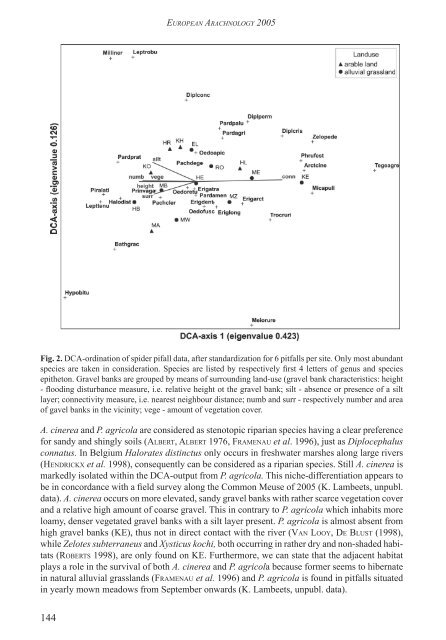(Araneae) of gravel banks and environmental constraints along a ...
(Araneae) of gravel banks and environmental constraints along a ...
(Araneae) of gravel banks and environmental constraints along a ...
Create successful ePaper yourself
Turn your PDF publications into a flip-book with our unique Google optimized e-Paper software.
144<br />
EuropEan arachnology 2005<br />
Fig. 2. DCA-ordination <strong>of</strong> spider pifall data, after st<strong>and</strong>ardization for 6 pitfalls per site. Only most abundant<br />
species are taken in consideration. Species are listed by respectively first 4 letters <strong>of</strong> genus <strong>and</strong> species<br />
epitheton. Gravel <strong>banks</strong> are grouped by means <strong>of</strong> surrounding l<strong>and</strong>-use (<strong>gravel</strong> bank characteristics: height<br />
- flooding disturbance measure, i.e. relative height ot the <strong>gravel</strong> bank; silt - absence or presence <strong>of</strong> a silt<br />
layer; connectivity measure, i.e. nearest neighbour distance; numb <strong>and</strong> surr - respectively number <strong>and</strong> area<br />
<strong>of</strong> gavel <strong>banks</strong> in the vicinity; vege - amount <strong>of</strong> vegetation cover.<br />
A. cinerea <strong>and</strong> P. agricola are considered as stenotopic riparian species having a clear preference<br />
for s<strong>and</strong>y <strong>and</strong> shingly soils (alBErt, alBErt 1976, FramEnau et al. 1996), just as Diplocephalus<br />
connatus. In Belgium Halorates distinctus only occurs in freshwater marshes <strong>along</strong> large rivers<br />
(hEndrickx et al. 1998), consequently can be considered as a riparian species. Still A. cinerea is<br />
markedly isolated within the DCA-output from P. agricola. This niche-differentiation appears to<br />
be in concordance with a field survey <strong>along</strong> the Common Meuse <strong>of</strong> 2005 (k. Lambeets, unpubl.<br />
data). A. cinerea occurs on more elevated, s<strong>and</strong>y <strong>gravel</strong> <strong>banks</strong> with rather scarce vegetation cover<br />
<strong>and</strong> a relative high amount <strong>of</strong> coarse <strong>gravel</strong>. This in contrary to P. agricola which inhabits more<br />
loamy, denser vegetated <strong>gravel</strong> <strong>banks</strong> with a silt layer present. P. agricola is almost absent from<br />
high <strong>gravel</strong> <strong>banks</strong> (KE), thus not in direct contact with the river (van looy, dE Blust (1998),<br />
while Zelotes subterraneus <strong>and</strong> Xysticus kochi, both occurring in rather dry <strong>and</strong> non-shaded habitats<br />
(roBErts 1998), are only found on KE. Furthermore, we can state that the adjacent habitat<br />
plays a role in the survival <strong>of</strong> both A. cinerea <strong>and</strong> P. agricola because former seems to hibernate<br />
in natural alluvial grassl<strong>and</strong>s (FramEnau et al. 1996) <strong>and</strong> P. agricola is found in pitfalls situated<br />
in yearly mown meadows from September onwards (k. Lambeets, unpubl. data).
















